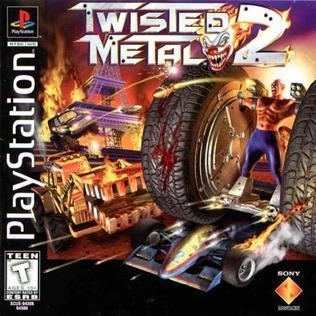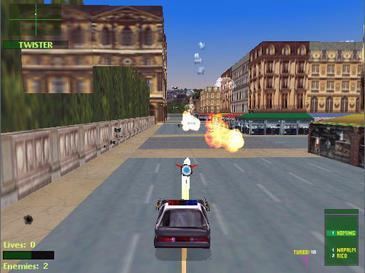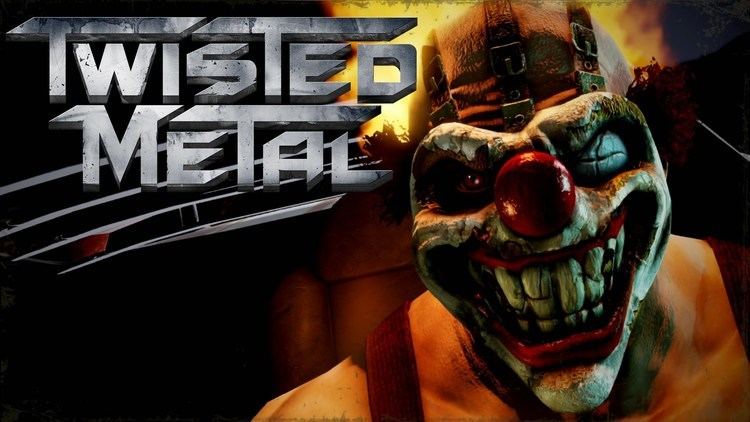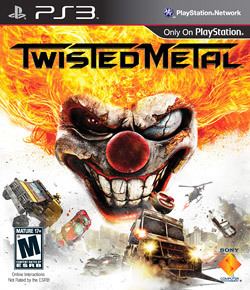Genres Vehicular combat | Genre Vehicular combat game | |
 | ||
Creators David Jaffe, Scott Campbell First release Twisted MetalNovember 5, 1995 Games Twisted Metal, Twisted Metal: Head‑On, Twisted Metal: Small Bra, Twisted Metal: Black, Twisted Metal 4 | ||
Cgrundertow twisted metal for playstation video game review
Twisted Metal is a series of vehicular combat video games published by Sony Computer Entertainment, and developed by various companies since its inception. The series is the longest-running PlayStation-exclusive franchise, which began on the original PlayStation in 1995, with seven additional games released since then, as well as two spin-off titles. Since the original, the series has appeared on subsequent PlayStation consoles, the PlayStation 2, PlayStation Portable, and PlayStation 3. The latest installment was released in 2012. As of October 31, 2000 the series has sold 5 million copies. Seven of the games (including Twisted Metal: Black Online) were re-released as part of the Sony Greatest Hits program. The original game and its first sequel were also released on PC.
Contents
- Cgrundertow twisted metal for playstation video game review
- Twisted metal ps3 gameplay classic death match sunsprings ca wikigameguides
- Overview
- Twisted Metal 1995 and Twisted Metal 2 1996
- Twisted Metal III 1998 and Twisted Metal 4 1999
- Twisted Metal Black 2001
- Twisted Metal Head On 2005
- Twisted Metal Head On Extra Twisted Edition 2008
- Twisted Metal 2012
- Twisted Metal Small Brawl 2001
- Twisted Metal Black Online 2002
- Twisted Metal Harbor City
- Twisted Metal Apocalypse
- Twisted Metal Revolution
- Recurring characters
- Calypso
- Sweet Tooth
- Mr Grimm
- Film adaptation
- References

Twisted metal ps3 gameplay classic death match sunsprings ca wikigameguides
Overview

In concept, Twisted Metal is a demolition derby that permits the usage of ballistic projectiles, machine guns, mines, and other types of weapons (up to and including satellite-based weapons and nuclear weapons). Players choose a vehicle, and an arena—or a series of arenas in the story mode—to engage in battle with opposing drivers. A variety of weapons and upgrades are obtainable by pick-ups scattered throughout the stage. The last driver alive is the winner.

Although each individual game features its own storyline, they all revolve around the eponymous "Twisted Metal": a vehicular combat tournament hosted once a year. In almost all of the games, the host is a man called "Calypso"; however, in the series' fourth installment, perennial contestant Sweet Tooth briefly takes over. The general goal is to destroy all opponents; apart from the other contestants, unique vehicles seemingly designed by the host themselves may stand in the competitors' path. The winner is brought before the tournament host, who will grant the contestant a single wish.
The hosts of these games are the persons who are, through arcane means, capable of warping reality itself to grant the wish of the contest winner; however, there is a general "be careful what you wish for" theme in the game series, as nearly all of the winning contestants end up with "not-so-happy" endings, due to the skill and proclivity of the hosts for twisting the words of their wish around—often to deadly effect. The games in the series usually contain a healthy dose of black humor.
Twisted Metal (1995) and Twisted Metal 2 (1996)
Format: PlayStation, PC
The first two Twisted Metal games were developed by SingleTrac.
An IBM PC version of Twisted Metal 2 exists. It features slightly cut-down graphics compared to the PlayStation version (minor details of some levels disappeared) but it doesn't require a 3D accelerator video card and played well on computers with lower processing capabilities. It also features multiplayer over a modem line or Internet.
Twisted Metal III (1998) and Twisted Metal 4 (1999)
Format: PlayStation
After a contractual dispute with SingleTrac, Twisted Metal development duties were handed over to Sony's in-house development team, 989 Studios. The Twisted Metal titles developed by 989 Studios were fundamentally different, due in no small part to the fact that SingleTrac owned the engine used in the first two titles and so an entirely new engine had to be built from scratch for the non-SingleTrac-developed entries. One of the major changes that resulted were the introduction of advanced physics simulation and AI techniques to the series.
David Jaffe, in speaking about these two entries in the series, was reported to have said, "....[in and of themselves] they're good games, they're just not good Twisted Metal games".
Twisted Metal: Black (2001)
Format: PlayStation 2
After developing several non-Twisted Metal vehicular combat games for GT Interactive, a large number of SingleTrac employees left the company to form the gaming studio Incognito Entertainment, and signed with Sony. With much of Twisted Metal's original creative team back with the company who owned the franchise, this reunion led to the creation of the series' first installment on the PlayStation 2, Twisted Metal: Black.
Twisted Metal: Head-On (2005)
Format: PlayStation Portable
Despite what was essentially a complete relaunch and rebranding of the franchise with Twisted Metal: Black, Incognito decided to return to the series' roots and create a game that felt more like a true follow-up to the original Twisted Metal series, bringing back the bright colors and cartoony characters of Twisted Metal 1 and 2. Available on the PSP in time for its North American launch, Twisted Metal: Head-On is considered by many fans – especially those disappointed by the non-Singletrac-developed titles – to be the true sequel to Twisted Metal 2. Utilizing the PSP's built-in online capabilities, it also marked the first time a Twisted Metal game had full online play available from the start.
Twisted Metal: Head-On: Extra Twisted Edition (2008)
Format: PlayStation 2
In February 2008, Eat Sleep Play, a new development studio formed by David Jaffe and Scott Campbell, released Twisted Metal: Head-On for the PlayStation 2. While primarily a direct port of the PSP game "Twisted Metal: Head-On", it does feature a number of extra features, most notably four complete and playable levels from the unreleased/incomplete Twisted Metal: Black sequel, called Twisted Metal: Harbor City. Other bonus content includes: a code to download the soundtrack (a timed offer which has since expired); a half-hour documentary on the series with some of the original developers called "Dark Past"; a rough playable portion of an unfinished and unreleased third person action game starring Sweet Tooth (controllable for the first time ever on-foot and outside of a vehicle); and the never before seen original live-action ending videos of all the characters from the first Twisted Metal, directed by Jaffe.
Twisted Metal (2012)
Format: PlayStation 3
Twisted Metal (2012) is the most recent game in the Twisted Metal series. It features multiple drivers and tracks. It also features multiplayer gameplay and other game modes. The game consists of three story arcs that focus on Sweet Tooth, Mr. Grimm and Dollface.
Twisted Metal: Small Brawl (2001)
Format: PlayStation
Instead of delivering a PlayStation 2 follow-up to Twisted Metal: Black, Incognito took an unexpected turn and developed Twisted Metal: Small Brawl for the original PlayStation, a Twisted Metal aimed at a younger audience that featured radio-controlled toy cars instead of full-size vehicles.
Twisted Metal: Black Online (2002)
Format: PlayStation 2
A game featuring only the multiplayer portion of Twisted Metal: Black, but playable online. A free copy could originally be obtained by mailing in a card that came packaged with the PlayStation 2 online network adapter. After Sony stopped offering the disc, it was later included as a bonus disc in subsequent reissues of the Greatest Hits version of Twisted Metal: Black. The servers to the game have since been shut down.
Twisted Metal: Harbor City
Format: PlayStation 2
A sequel to the PlayStation 2 game Twisted Metal: Black, titled Twisted Metal: Harbor City, was in development but was cancelled before it was announced when the series co-creators left the development team. At time of cancellation four levels had been completed; these levels were included and playable in Twisted Metal Head-On: Extra Twisted Edition as a special mode.
Twisted Metal: Apocalypse
Format: PlayStation 3
A Twisted Metal game set in a post-apocalyptic environment, which was originally in development in 2008 but was scrapped. Artwork of the cancelled game was released by David Jaffe at the San Diego Comic-Con International; it showcased concept arts of locations such as a destroyed Mount Rushmore as well as a giant crater. It was also revealed that the Eat Sleep Play team was originally rather keen on the idea, though it was hinted by Jaffe that the idea was rejected by Sony Computer Entertainment, speculated to be because of the release of MotorStorm: Apocalypse, a racing game which also featured a post-apocalyptic environment.
Twisted Metal: Revolution
Format: PlayStation 3
Apart from Twisted Metal: Apocalypse, another Twisted Metal game was in development for the PlayStation 3 which utilized street culture and hip-hop influence. The game was titled Twisted Metal: Revolution, but it was cancelled; it would have featured characters with a more realistic look such as a Sweet Tooth that looked more of a smooth criminal rather than a psychopathic clown. Other characters included yakuza, FBI agents and street gang members. David Jaffe compared the game to Rockstar's Midnight Club series when describing the look and feel of the game. In addition, Jaffe said that it was extremely difficult to portray the environments that they had created in their concept art within the game as it resulted in an extremely bland environment.
Recurring characters
Twisted Metal features 50 different cars (although some different combinations of car and driver) in its eight incarnations (Twisted Metal, 2, III, 4, Black, Small Brawl, Head-On, and TM2012.) Many characters appear in more than one game of the series, although the same vehicles are not always driven by the same people.
Calypso
Calypso, playing the role of main antagonist in the series, is a playable character in Twisted Metal 4, while in other games, he appears only in the opening and ending cutscenes.
Before creating the Twisted Metal contest, Calypso was just a regular family man with a daughter, wife, and a different name. He led a normal life like anyone else, until one night he was involved in a freak accident in which he crashed his car directly into a brick wall. The crash killed his wife (revealed to be Pam Sparks) and his daughter (later revealed to be Krista Sparks, the driver of the car Grasshopper; extrapolating from this, Calypso's original last name might be Sparks), and it also burned and disfigured his face. During this time, it's been hinted at that Calypso did a few things: first, he made a deal with Mr. Ash (the original driver of Darkside) to come back to life in exchange for collecting souls. Second, either by trickery or as a part of the deal itself, he obtained the power to grant wishes. Whether the power is demonic remains unclear. If it is demonic, it was most likely stolen from the driver Minion, who later competes in the contest himself in order to regain it. Two years after his disappearance, during which he was assumed dead, Calypso emerged. He established Twisted Metal and, for ten years, has continuously run the competition. This is where the first Twisted Metal game comes in.
When someone wins his contest, the winner gets to have one wish granted. These comprise the game's ending sequences. It should be noted that while Calypso seems to stick to the phrasing of a wish, he will gladly violate its spirit, which usually causes the wisher harm in the end (such as wishing for the ability to fly has him get the wisher's plane tickets, only telling them after they jumped off a building), though in the original game, Black, and Head-On he generally granted the character's wish directly without any harmful tricks, so long as the wisher's intents were malevolent, while the more noble wishes got turned around. The scope of his powers seem to have extraordinary bounds. Even with this, though, there are still limits as to just what he can grant.
Similarly, the meaning of the ending for Roadkill in Twisted Metal 2 is ambiguous – Marcus Kane's (the driver) wish is to wake up from the nightmare he believes he is trapped in. After winning the contest, Kane awakes up in a hospital bed, surrounded by his family and relatively unscathed. They are surrounded by some of the other contestants, all of whom are severely injured; although Kane recognizes them, he can't remember why or how. It is unclear which was real and which was the hallucination: the scene in the hospital or the Twisted Metal contest.
Calypso is, to some extent, a prisoner of the Twisted Metal contest himself: he can't, for example, restore his daughter to 'life' unless she wishes for it. Additionally, endings in Twisted Metal, Twisted Metal 2, and Head-On show that his power seems to extend only to granting wishes; he can't, for example, stop Agent Shepard from arresting him via his powers, as Shepard refused to accept a wish. Similarly, in Twisted Metal 2, he could not prevent Shadow from taking his soul as revenge for all the people who died due to the Twisted Metal competition. Also, in Twisted Metal: Head-On, Sweet Tooth wishes to change places with Calypso and, despite Calypso's refusal, it was granted.
Calypso's character design is inconsistent. It is different in many Twisted Metal games throughout the series. In terms of appearance, the most notable change is his hair which varies from thick and long to completely bald or long hair on the sides.
Sweet Tooth
Sweet Tooth, real name Marcus "Needles" Kane, is designed around the premise of a killer clown who drives an ice cream truck, and his face has been featured on the cover of every Twisted Metal game to date, making him the series mascot. He is the only character besides his split-personality Marcus Kane to drive more than one vehicle in any of the games, being the driver of Head-On's Dark Tooth, Tower Tooth, and as of Twisted Metal Lost, Gold Tooth. He is voiced by J. S. Gilbert in Twisted Metal: Black and Twisted Metal (2012).
Mr. Grimm
Mr. Grimm is a character in the Twisted Metal series, he is the Grim reaper, Skeleton and incidentally his Motorbike is also named Mr. Grimm. Following the original Twisted Metal Tournament, Mr. Grimm became the Grim Reaper in 2005 and Calypso has been the only one able to elude him. Also, it seems Calypso made some sort of "deal" with him. Mr. Grimm appears in Twisted Metal (2012) as the leader of his own faction, The Skulls. Unlike most games, this version of Mr. Grimm is not the Grim Reaper, but an African-American criminal and murderer named Daniel Grimm, whose stuntman father lost his life during a performance. He blames his father's death for the bad life he grew into; thus, he hopes to win the competition in order to prevent his father's death from happening.
Film adaptation
In February 2012 it was announced Sony Pictures Entertainment was bringing Twisted Metal to the big screen by hiring Crank, Crank: High Voltage, Gamer and Ghost Rider: Spirit of Vengeance co-director Brian Taylor to write and direct the film. As of 2017, the film has not been produced.
